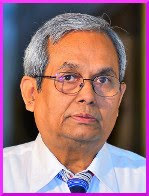_
 (L-R): U.S. astronauts of the Apollo 11 Mission: Neil Armstrong,
(L-R): U.S. astronauts of the Apollo 11 Mission: Neil Armstrong,
Michael Collins, and Edwin Aldrin Before landing on the moon (below), astronauts are viewing
Before landing on the moon (below), astronauts are viewing
the earth-rise (above) over the lunar horizon A crater (No. 308) of the moon as seen before their landing
A crater (No. 308) of the moon as seen before their landing Astronaut Edwin Aldrin in front of the U.S. flag planted on the moon
Astronaut Edwin Aldrin in front of the U.S. flag planted on the moon During their return trip from the moon, astronauts viewed
During their return trip from the moon, astronauts viewed
the earth as a crescentPhotos Courtesy: http://history.nasa.gov/It was July 20, 1969. The perennial dream of man to be on the moon was realized with the landing of two American astronauts on this day four decades ago. All the myths, folklores and fables, that developed in the imagination of man from time immemorial, came to a reality. Man himself was on the moon in real flesh and blood.
U.S. President John F. Kennedy, on May 25, 1961, had announced the goal of U.S. astronauts' landing on the moon before 1970. His aspiration was fulfilled when Neil Armstrong stepped out of the lunar module and set foot on the moon by saying:
"That's one step for a man, one giant leap for mankind."The Apollo 11 mission to the moon consisted of Mission Commander Neil Alden Armstrong, Command Module Pilot Michael Collins, and Lunar Module Pilot Edwin Eugene "Buzz" Aldrin. They started their mission from the earth on July 16, 1969 and landed on the moon July 20. Neil Armstrong and Edwin Aldrin were the first human beings to land on the moon, while Michael Collins orbited around the moon.
The Influence of the Moon on MankindMan was obsessed with the moon. His imagination gave free reign to develop myths, folklores, fables, literature, songs, and lullabies. So, the influence of the moon on mankind cannot be denied.
The moon also has a powerful influence on the water system of the earth. Tides and ebbs are the results of the gravitational pull of the moon.
Man also has water in his body. In fact, more than 90% of his body is water. The moon, therefore, has some effect on man -- more or less. Some get influenced by it more than others.
From experience man came to the understanding that some persons behave erratically or irrationally during the full moon phase. For this reason, the words like
lunatic,
moonstruck came into being. How much scientific basis is there we don't know, but this syndrome has been observed in almost in all cultures and they have coined particular terms for this condition in their languages.
The Skeptics of the Moon LandingThere are skeptics who still believe that the American astronauts' moon landing did not happen. They believe that the landing on the moon was a great hoax perpetrated by the American government with careful rehearsal in a desert in the U.S.A.!
These skeptics will always remain among us, as there are skeptics who believe that 9/11 was not caused by outsiders, rather the American government did it to start a war in Afghanistan. Similarly, there are expatriate Tamils who still believe that Tamil Tigers leader Vellupillai Prabhakaran was not killed, only his double was murdered by the Sri Lankan goverment. The existence of such skeptics is dependent on disbelief. They expend a lot of time, energy and even money in proving their points. Even if you take them to the moon, still they will say that it was only a dream!
I see the usefulness of having such skeptics in our society. They help us strive harder to prove our point, to reveal the truth more fully. They help us go farther. We will always remain backward if we just be gullible and listen to them and act according to their dictates.
Moon to MarsScientists are getting ready to colonize the moon and even to explore the Mars in future. Many of us may not be able to see it, but I strongly believe that a day will come when these new dreams and aspirations will come to fruition.

 Bangladesh President H. M. Ershad welcomes
Bangladesh President H. M. Ershad welcomes President H. M. Ershad (left) introduces Pope John Paul II (right)
President H. M. Ershad (left) introduces Pope John Paul II (right) The red-carpet welcome for the pope at the airport. Christians,
The red-carpet welcome for the pope at the airport. Christians, Pope John Paul II ordains 19 Bangladeshi seminarians
Pope John Paul II ordains 19 Bangladeshi seminarians The Pope is paying his tribute to the Jatiyo Smriti Shoudha
The Pope is paying his tribute to the Jatiyo Smriti Shoudha Pope John Paul II is writing his message on the
Pope John Paul II is writing his message on the Dancers demonstrating their respect for the Pope at the solemn
Dancers demonstrating their respect for the Pope at the solemn























